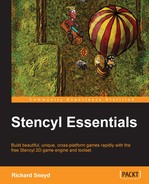Having learned the process of building a prototype of your game, you now have the necessary basic skills to go ahead and start working on your own game ideas, then flesh them out into full-fledged games—honing and building upon the foundational knowledge you have acquired by reading this book as you do so. If you ever want to become a professional, independent game developer, however, you will have to learn about and experiment with the game publishing and monetization options at your disposal. It is beyond the scope of this book to provide an exhaustive, step-by-step guide to set up a monetization system for your games, but we will explore the general process in sufficient detail so that you can get started with the process without the need to do a lot of additional research. In this chapter, we will learn:
- The basic process involved in publishing Stencyl games to the various supported platforms
- The key stores and marketplaces that are most established for the purpose of distributing said games
- The different monetization models, and how to implement them in Stencyl
- The necessary steps required to implement ads and purchases within Stencyl games
The Proof of Concept (POC) game prototype we developed in this book was conceptualized, from the ground up, to lend itself to both mobile and desktop targets. The gameplay and interface, however, are certainly more suited to the conventions of the casual mobile market, so we will focus on this publishing option. Mobile publishing also happens to be the most popular first choice for fledgling game developers, largely due to the low barriers to entry as well as the comparatively shorter development cycle required to create a quality mobile game, as opposed to a quality desktop game.
The two principle mobile platforms to which you may wish to publish your Stencyl creations are:
- iOS: Publishing to iOS requires that you have a developer's license with Apple, which, at time of writing, stands at $99 per year. It is also necessary to purchase at least one modern Apple device for testing purposes but, preferably, you would have a modern version of both an iPhone and an iPad to test your games for both hardware specs and screen dimensions, using the most recent version of the operating system (iOS). If you intend to sell your game outright, then it would be a good idea to think seriously about publishing to iOS, as it is known to be a more affluent market, in which the consumers are more inclined to purchase games and apps outright.
- Android: The most popular Android app store at this time is Google Play, followed by Amazon, and Samsung Apps. I advice that you publish your game to all of these stores to maximize the exposure. There is currently no residual, or a yearly licensing fee for any of these stores, as is the case with the Apple App Store, although Google does charge a nominal, one-off fee of $25 to register as a developer for the Google Play Store. It is harder to make money by selling games on the Android app stores, as this market is known to be more spending-conscious as a whole when compared with iPhone and iPad users. Advertising and in-app purchases are generally the preferred monetization methods for Android games, although there are no hard and fast rules on this subject. The crux of the matter is, that if you want to sell your game outright, you'll have to do a really good job of convincing your prospective customers that the gaming experience will be worth the money.
Displaying ads within your games is one of the easiest monetization methods to implement. Be aware, however, that your ad revenues are not likely to be terribly high unless you achieve very large download and distribution volumes for your games. However, don't despair, as it can and has been done! Mobile game ads come in two basic forms:
- Interstitial ads: This type of an ad is usually large, or even full-screen, and appears between gameplay sessions—for instance, when transitioning from one scene to another. If the ads are varied and of interest to your key demographics, they are less likely to cause frustration for your players than banner ads.
- Banner ads: These ads tend to be relatively small, and offset either to the top or the bottom of the screen. They appear during gaming sessions. A word of caution here; if you overuse this kind of ad in your games, your players will likely become frustrated, and this can lead to low retention rates and even bad reviews, which will not help your game climb the charts. These are used sparingly, although they can be an effective means of boosting your overall ad revenue.
All of the blocks related to ads and purchases for the iOS and Android (mobile) targets are accessible and can be triggered in all Actor and Scene Behaviors. To do so, perform the following steps:
- Simply navigate to Game | Mobile in the blocks palette, as shown in the following screenshot:
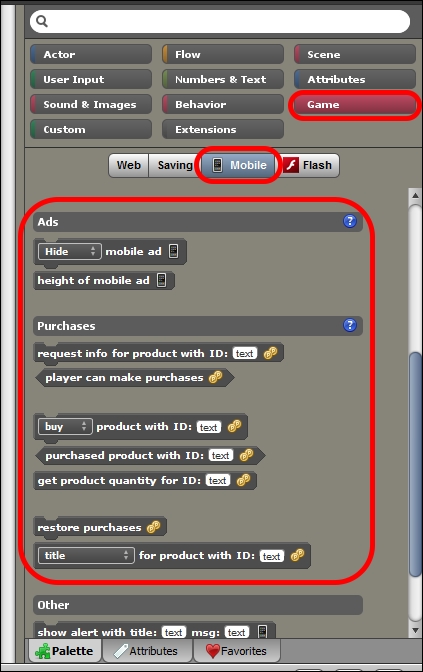
- For these blocks to work; however, we must first provide some API (Application Programming Interface) information to Stencyl, in Game Settings. To find the Monetization settings area, click on the Settings button at the top of the screen to launch the Game Settings window, as shown in the following screenshot:

- In the Game Settings window that appears, select Mobile, then Monetization. You will see two blank fields, AdMob Publisher Key and Android Public Key, as highlighted in the following screenshot:
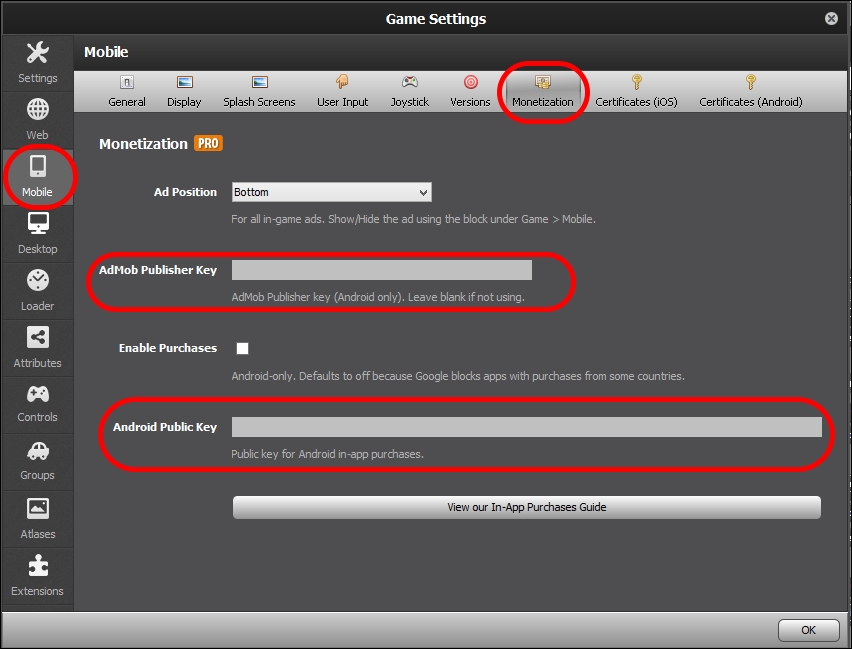
- The AdMob Publisher Key is a unique ID that is provided to you when you sign up for an AdMob account—AdMob being Google's very own ad network for games and apps. You can simply copy and paste it from the AdMob publisher dashboard into this field to make the ad blocks functional.
- The Android Public Key is an ID that is provided by the Google Play Store and is required to enable in-app purchases in your game. Simply copy and paste it over, once you have created your Google Play developer account.
For more detailed information about implementing purchases within your Stencyl game, click on the View our In-App Purchases Guide button, as shown in the previous screenshot.
Stencyl supports the creation of third-party engine extensions that can be downloaded from the Stencyl website and integrated into your game projects. Many have already been created and shared freely by some hard-working, generous members of the Stencyl community, which add very useful functionality to your games, or enable the use of third-party APIs. Many of these extensions enable the use of various popular advertisement APIs that are not supported, out of the box, by Stencyl. Some of the most popular ones are:
To implement a third-party extension for the purpose of enabling an additional ad network, for instance, follow these steps:
- In the Game Settings window, select Extensions, and you will be presented with a list of all the extensions currently available in your installation of Stencyl. Hence, the list of extensions that you see will vary considerably from the one presented in the following screenshot:

- To find some useful ad extensions to install, click on Get More Extensions, as shown in the previous screenshot. This will take you to the appropriate section of the Stencyl website.
- Click on Download for the AdMob extension, highlighted in the following screenshot. This extension improves the default AdMob support built into Stencyl, and even allows us to use AdMob with iOS so that we can utilize the same ad network on both the targets, as shown in the following screenshot:

- In the forum thread that appears, scroll down until you see a link that says Download AdMob Extension. Click on it to start the download.
- The downloaded file is called
admob.zip. Back in Stencyl, click on Install Extensions, and navigate to and selectadmob.zipto install it. After a few moments, you will see it appear in the list of installed extensions. Click on the Enable button highlighted in the following screenshot, and then close and reopen the game for the extension to properly activate:
Open the Player Handler behavior again, and select Extensions from the blocks palette to see all of the new blocks that have been added by the AdMob extension as shown in the following screenshot:
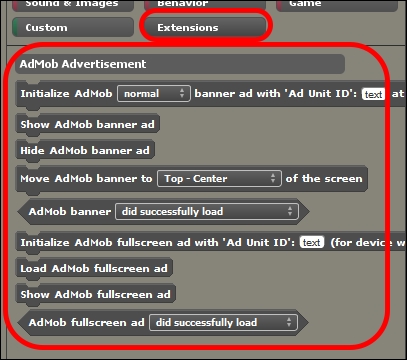
You will see from the preceding screenshot that this AdMob extension adds quite a bit of additional functionality to the default AdMob support provided by Stencyl. The two most significant additions are the ability to use fullscreen or interstitial ads, and the ability to use the same ad network and blocks on both Android and iOS.
Both Apple and Google require that you embed a certificate in your published game file, in order to be allowed to publish them to the App Store or Google Play, respectively. In the case of App Store certificates, the process is quite involved and beyond the scope of this 'essentials' guide. To learn the general process, I would recommend that you follow the guide provided by the Stencyl team at www.stencyl.com/help/view/ios-getting-started. In the case of Android certificates, however, the process is much more straightforward. Follow these steps:
- In the Game Settings, go to Mobile, then select Certificates (Android). You will see the following screen:
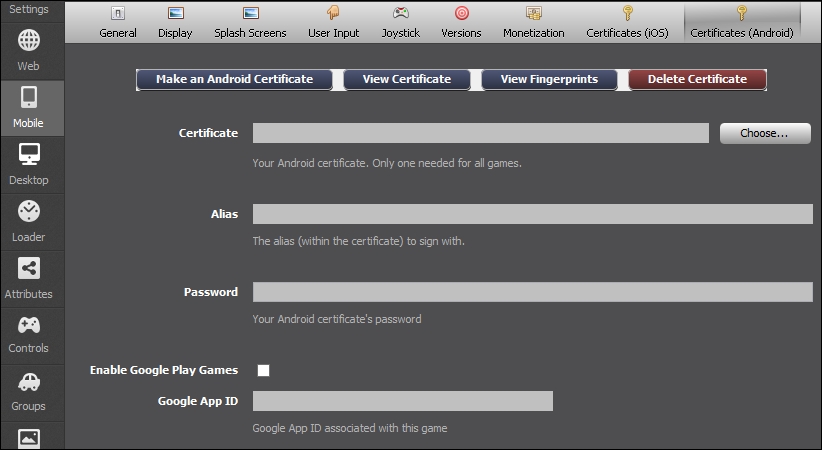
- Even if you have never made an Android certificate before, click on Make an Android Certificate. You will have to provide an Alias (name), a Password (to keep it secure), your First & Last Name, Company, and your 2 Letter Country Code. Once you click on OK, your certificate will be created.
- Remember where this certificate is saved, and keep it safe by making multiple backup copies. You can use the exact same certificate for all of your Android games from now on, so you would never need to create a certificate again if you hold on to this one. Also, if you lose it, you may not be able to update your old games on Google Play, so keep it very secure.
